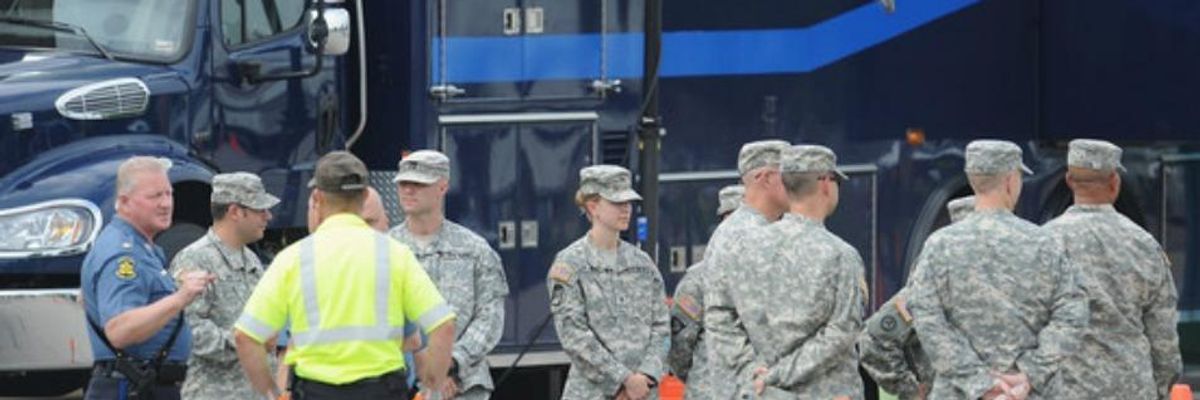

SUBSCRIBE TO OUR FREE NEWSLETTER
Daily news & progressive opinion—funded by the people, not the corporations—delivered straight to your inbox.
5
#000000
#FFFFFF
To donate by check, phone, or other method, see our More Ways to Give page.


Daily news & progressive opinion—funded by the people, not the corporations—delivered straight to your inbox.

Initial personnel from the Missouri National Guard arrive at the Missouri Highway Patrol command center in Ferguson, Mo. (Photo: AFP/Getty Images)
On August 16, Missouri Governor Jay Nixon called National Guard troops into Ferguson to "ensure the safety and welfare of the citizens." This call came amid international debate over the militarized police response to protests that were sparked by the police killing of unarmed teenager Michael Brown. Commentators have questioned why, on top of heavily armed riot teams, the governor needs the National Guard?
Rarely deployed to deal with civilian unrest, in most instances National Guard troops lay sandbags and hand out bottles of water. But as troops turned up in Ferguson on Monday clad in military fatigues and equipped with rifles, they aroused memories of America's past.
In Ferguson these civilian soldiers were clearly not there to just hand out water. As Monday night's images of excessive force showed, the National Guard was called in to protect the police, not the people. Through wafts of tear gas, with guns ready, these troops provided military backup to an already militarized police force. For many, this is like rubbing salt in a community's wounds. And as a closer look at the history of National Guard deployments makes clear -- from Kent State to the Los Angeles riots -- its presence often serves to justify police violence.
Read the full article at Al-Jazeera America.
Dear Common Dreams reader, The U.S. is on a fast track to authoritarianism like nothing I've ever seen. Meanwhile, corporate news outlets are utterly capitulating to Trump, twisting their coverage to avoid drawing his ire while lining up to stuff cash in his pockets. That's why I believe that Common Dreams is doing the best and most consequential reporting that we've ever done. Our small but mighty team is a progressive reporting powerhouse, covering the news every day that the corporate media never will. Our mission has always been simple: To inform. To inspire. And to ignite change for the common good. Now here's the key piece that I want all our readers to understand: None of this would be possible without your financial support. That's not just some fundraising cliche. It's the absolute and literal truth. We don't accept corporate advertising and never will. We don't have a paywall because we don't think people should be blocked from critical news based on their ability to pay. Everything we do is funded by the donations of readers like you. Will you donate now to help power the nonprofit, independent reporting of Common Dreams? Thank you for being a vital member of our community. Together, we can keep independent journalism alive when it’s needed most. - Craig Brown, Co-founder |
On August 16, Missouri Governor Jay Nixon called National Guard troops into Ferguson to "ensure the safety and welfare of the citizens." This call came amid international debate over the militarized police response to protests that were sparked by the police killing of unarmed teenager Michael Brown. Commentators have questioned why, on top of heavily armed riot teams, the governor needs the National Guard?
Rarely deployed to deal with civilian unrest, in most instances National Guard troops lay sandbags and hand out bottles of water. But as troops turned up in Ferguson on Monday clad in military fatigues and equipped with rifles, they aroused memories of America's past.
In Ferguson these civilian soldiers were clearly not there to just hand out water. As Monday night's images of excessive force showed, the National Guard was called in to protect the police, not the people. Through wafts of tear gas, with guns ready, these troops provided military backup to an already militarized police force. For many, this is like rubbing salt in a community's wounds. And as a closer look at the history of National Guard deployments makes clear -- from Kent State to the Los Angeles riots -- its presence often serves to justify police violence.
Read the full article at Al-Jazeera America.
On August 16, Missouri Governor Jay Nixon called National Guard troops into Ferguson to "ensure the safety and welfare of the citizens." This call came amid international debate over the militarized police response to protests that were sparked by the police killing of unarmed teenager Michael Brown. Commentators have questioned why, on top of heavily armed riot teams, the governor needs the National Guard?
Rarely deployed to deal with civilian unrest, in most instances National Guard troops lay sandbags and hand out bottles of water. But as troops turned up in Ferguson on Monday clad in military fatigues and equipped with rifles, they aroused memories of America's past.
In Ferguson these civilian soldiers were clearly not there to just hand out water. As Monday night's images of excessive force showed, the National Guard was called in to protect the police, not the people. Through wafts of tear gas, with guns ready, these troops provided military backup to an already militarized police force. For many, this is like rubbing salt in a community's wounds. And as a closer look at the history of National Guard deployments makes clear -- from Kent State to the Los Angeles riots -- its presence often serves to justify police violence.
Read the full article at Al-Jazeera America.